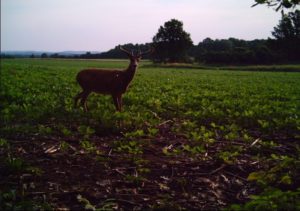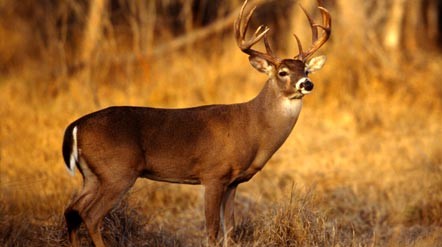Slow down, observe, and listen
Hunters know identifying a quality stand site takes more planning in advance than simply heading to a hunting lease, finding a tree that looks like it’s in a good spot, and hanging a stand. You must account for wind direction and the travel patterns of wildlife in order to locate a spot that will give you a good chance of spotting and harvesting deer. A good place to start is understanding travel routes.
Understanding Deer Behavior in Early Spring:
Early spring, the whitetail world is waking up. Winter’s grip is fading, and the deer are shifting from surviving to thriving. Food sources are changing with fresh green shoots popping up, and deer are adjusting accordingly. They’re sticking close to their bedding areas and following familiar routes that offer the easiest path to food and water.
Identifying these routes means reading the signs left behind by these crafty critters. But it’s not just about recognizing a track or a rub – it’s about understanding what it all means in the bigger picture.

-
Reading the Land
Deer aren’t random wanderers. They use the lay of the land, following ridgelines, creek bottoms, and fence lines. Look for these features, and then watch for signs of deer activity – tracks, droppings, rubs – they’re all telling a story.
-
Food and Shelter
In early spring, a deer’s mind is on food. They’re looking for green shoots, agricultural fields, food plots, and clear-cuts. Spot these areas and you’ve found the dinner table. Next, look for the bedrooms – deer like thick, brushy cover, or areas with a mix of young and mature trees. Position yourself between food and shelter, and you’re in the game.
-
Every Region Has Its Story
Deer habits can change depending on whether you’re hunting in the Northeast, Midwest, or the Southeast. It all depends on how harsh the winter has been. State fish and wildlife agencies like New York Department of Environmental Conservation or the Texas Parks and Wildlife Department can offer some great insights into regional deer behavior.

-
The Trail Camera Advantage
Trail cameras, like those from our friends at Muddy Outdoors, can be your eyes in the woods 24/7. They’ll capture deer movement and help you see patterns you’d miss otherwise. Set them up along suspected travel routes, near food sources, and around bedding areas. Remember, you’re trying to capture a deer’s world, so think like a deer when you set up your camera.
-
Scouting and Shed Hunting
Spring is a perfect time to scout. As the snow melts, deer signs from the previous fall start appearing. Look for last year’s rubs, scrapes, tracks, and trails. Finding sheds can also give you a good idea about buck travel routes.
-
Piecing It Together
Finding deer travel routes in early spring is like solving a puzzle. You’ve got to put together landscape features, food sources, bedding areas, regional differences, and game camera intel. It’s a test of patience, knowledge, and love for the hunt.
7. Pay Attention to Changing Conditions
We hunters know that the woods are always changing, always adapting. Over the years, many of us have noticed subtle shifts in the behavior of our whitetail friends. These aren’t just random variations – they reflect the changing conditions in our forests and fields.
In recent years, we’ve noticed that early springs are warmer than they used to be. This is affecting the green-up dates of plants and crops, which in turn impacts when and where deer move in search of food. The green-up is starting earlier, meaning the deer are shifting their patterns sooner.
As a hunter, it’s essential to stay alert to these changes. The traditional dates and signs that used to signal the start of spring and the shifting of deer travel routes might not be as reliable as they once were. If you notice that the underbrush is getting greener earlier or that crops are sprouting sooner, it might be time to start scouting those deer travel routes earlier in the season.
This shifting timeline also means that food sources that were traditionally available later in the spring might now be accessible to deer in the early spring. This can result in deer changing their routes to take advantage of these early-blooming food sources. So, if you’ve got a food plot or know of a crop field that’s showing green early, keep a close eye on it. It might just become a hot spot for deer activity.
Conclusion:
Finding deer travel routes in early spring is a journey of discovery. It’s about understanding the whitetail’s world and learning to see the woods through their eyes. Here at thehuntingpage.wpengine.com, we’re committed to helping you understand, respect, and ultimately be successful in this world. As you step into the woods this spring, remember to slow down, observe, and listen. The deer are the true masters of this game, and they’ve got a lot to teach us. So, lace up those boots, grab your gear, and let’s get out there. The woods are calling, and the whitetails are waiting. Now get after it!
Photo: Wyoming Game and Fish



















![The Best Deer Camp Chili [VIDEO] Deer Chili Ingredients, Tomatoes, Chili Spices](/wp-content/uploads/2015/10/Deer-Chili-Deer-Camp-Recipe-218x150.jpg)
![How to Call Elk Early in the Season [VIDEO]](/wp-content/uploads/2016/08/byers003-218x150.jpg)




![Idiots Disturb Hunter: How Would You Have Handled It? [VIDEO]](/wp-content/uploads/2015/10/DSC00110-e1474487693878-100x70.jpg)
![Albino Buck Shocked to Shed His Antlers [VIDEO]](/wp-content/uploads/2015/10/AlbinoDeer-100x70.jpg)